Fairey
Firefly Mk. V
Matilda
II
Hawker
Siddeley Harrier GR.1
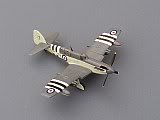
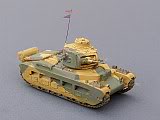
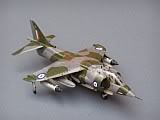
December 2010
|
Fairey
Firefly Mk. V |
|
![]()
![]() This
Month's selected
WW2 70th Anniversaries:
This
Month's selected
WW2 70th Anniversaries:
7 December 1940. Operation COMPASS - The British 7th Armoured Division, Indian 4th Infantry Division and British 16th Infantry Brigade advance into Italian-held Libya to begin the North African Campaign. By 15 December, the Western Desert Force has captured Sidi Barrani, taken 38,000 Italian prisoners and captured 400 artillery pieces, plus 50 tanks, while suffering casualties of 133 killed, 387 wounded and 8 missing. The Australian 6th Division captures Bardia, whilst the 7th Armoured Division begins the advance to surround Tobruk.
12/15 December. Luftwaffe air raids devastate the city of Sheffield.
16 December. RAF Bombers conduct area bombing of the German city of Mannheim.
29/30 December. "The Second Great Fire of London" Luftwaffe bombers conduct the most destructive raids of the Blitz, destroying large areas of London.
It'll all be over by Christmas - Part 1
Fairey Firefly V 810 Sqn Fleet Air Arm, HMS THESEUS, Korea 1950.
Airfix, 1/72, with own decals
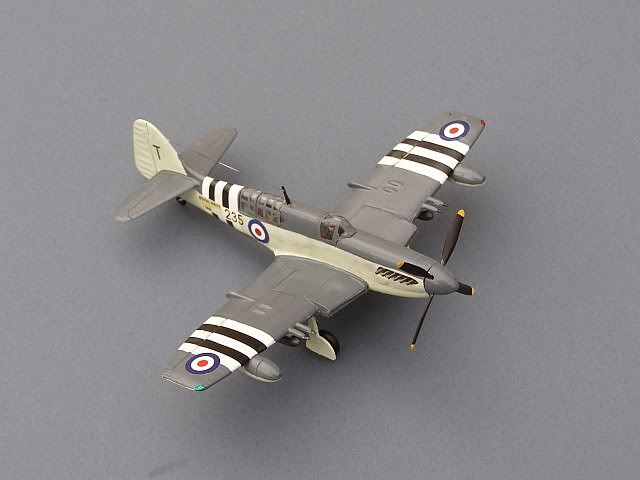
The Rolls Royce Griffon-powered Firefly continued the FAA policy of large 2-seat Fighter-Reconnaisance aircraft, started with the Hawker Osprey. Built to replace the Fulmar, it was a far better aircraft, particularly well suited to open sea and long range missions. By the start of the Korean War, the Royal Navy was mainly using the later Mk.V variant, with its clipped wings and wing-root radiators. Fireflies were particularly active over Korea, providing close support to Korean and UN ground forces.
HMS THESEUS arrived in Korean waters in October 1950 to relieve HMS TRIUMPH, with her Sea Furies and Fireflies conducting intensive strikes on North Korean bridges and vehicles. THESEUS' Ship's Company were confident that their Korean War mission would end soon and that and they would be on their way home, hopefully via an Christmas stand-off in an exotic far-east port (Hong Kong was the favourite). But with massive Chinese intervention in the war, UN forces were again being pushed south so after a very brief New year rest in Japan, THESEUS and her aircraft were back in action, operating from the Yellow Sea as the bitter Korean winter set in. Twelve of THESEUS aircraft were lost to a combination of ground fire, air to air combat and accidents during this period of combat, which was to last another full year. THESEUS finally left Korean waters to return to Rosyth for refit in January 1952.
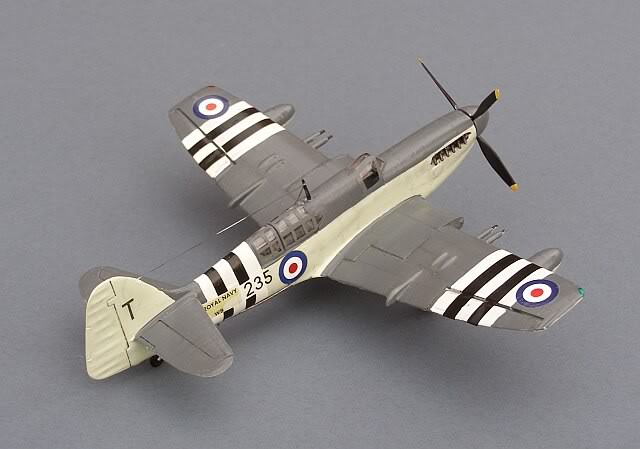
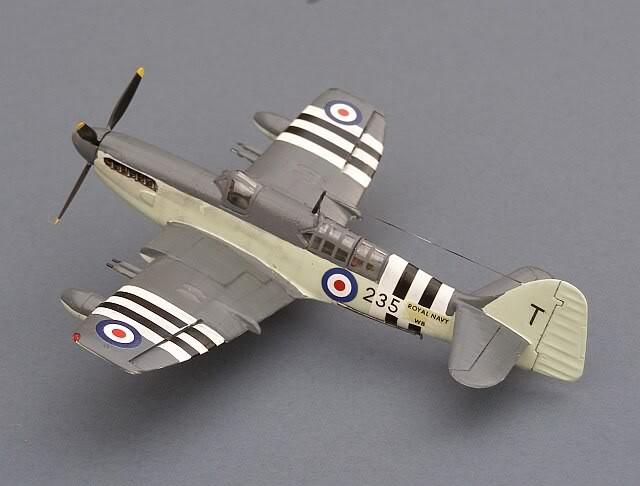
I have long wanted to build the Airfix Firefly, not least because its original Roy Cross box-artwork is one of his best. However, despite having an example of the kit in my stash for the last 20 years or so (!), I have only now got round to building it, as part of my Korean War theme, commemorating the events of 60 years ago.
This particular kit was an Airfix "blueprint box" issue, in a delightful bright blue shade of plastic. Despite its age (first issued in 1965), the kit is a very satisfying build. Unusually, it comes with a reasonable folded wing option, yet is sufficiently finely engineered and moulded to allow it to be built fully spread as well. Inside the pilot's cockpit there is little in the way of detail, but you can't actually see anything, so all I did was add seatbelts. The Observer's cockpit is reasonably well detailed, but again I added some belts just to liven it up a bit.
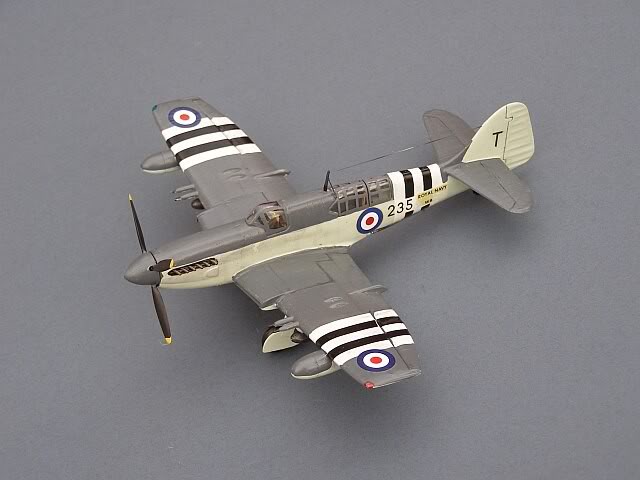
Like most Airfix kits of that era, it has some rather substantial rivet detail, so this was largely sanded off. Canopies fitted well, albeit with a small step between the rear canopy sections. My undercarriage ended up being a little wonky, mainly my own fault rather than the kit.
The supplied decals in this issue cover one of the aircraft transferred to the Royal Australian Navy (817 Sqn) for operation from HMAS SYDNEY, as the Commonwealth's on-station Korean carrier in 1952. These were quite badly yellowed, so I replaced them from my spares collection, choosing one of THESEUS' aircraft from December 1950 instead. Airfix provide reasonable decals for the Korean invasion stripes, although the method of fitting them isn't clear from the instructions. However, because the white was very yellow, I cut out the black stripes and applied them over white paint instead, giving a reasonable finish.
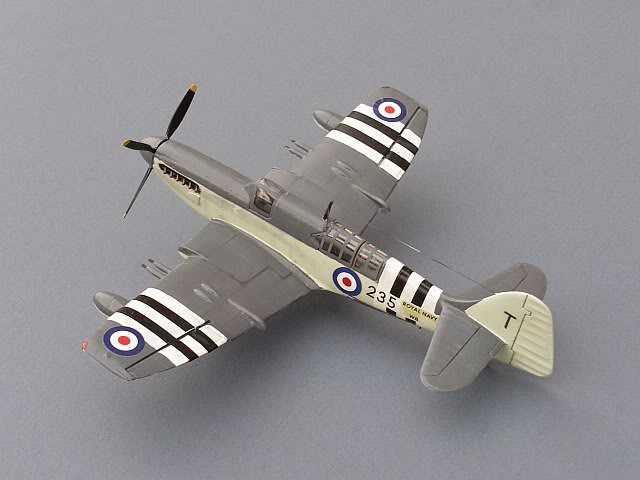
All in all, a good (if simple) kit which is recommended; if I can find another one, it will be done with the wings folded!
Other Korean War models on my website:
|
Supermarine Seafire 47 |
|
|
Hawker Sea Fury FB.11 |
|
|
MiG-15 |
|
Link to Korean War website
Link to my post-war RN Aircraft pages
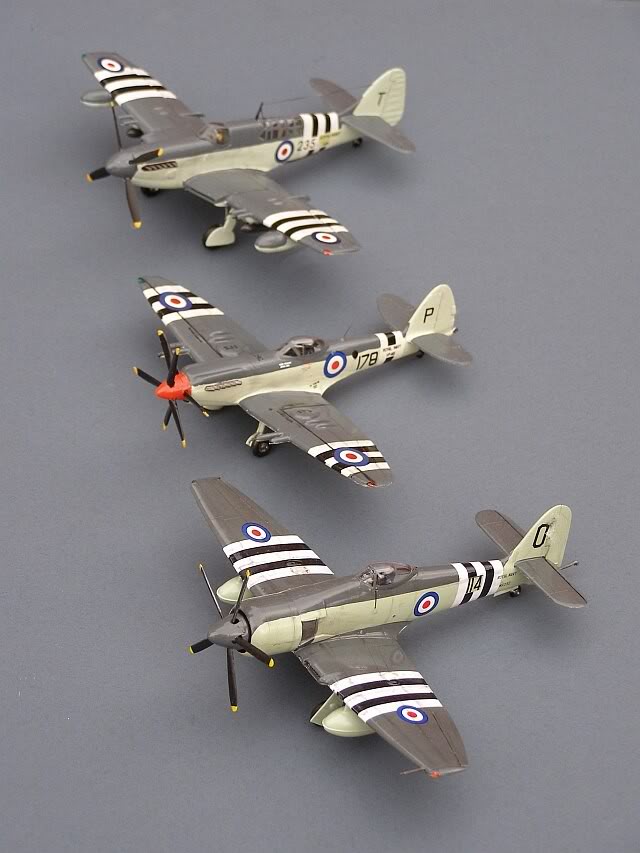
Sea Fury, Seafire & Firefly
WW2 70th Anniversary - Operation Compass - The tide turns.
Matilda II Infantry Tank, 7th Royal Tank Regiment, Operation Compass
Western Desert, December 1940
Airfix, 1/76(?), with own decals

Operation Compass was the first real Allied offensive of WW2 and was an unqualified success. On 7th December 1940, with the Italian Navy bottled up in port and unable to support its army, thanks to the Fleet Air Arm's success at Taranto and the resilience of the beseiged island of Malta, General Wavell's Western Desert Force advanced aggresively into Libya, taking the Italians by surprise. The 7th RTR's Matilda infantry tanks deployed along the Libyan coast in support of the 4th Indian Infantry Division, which attacked and destroyed the Italian "Maletti Group" at the Nibeiwa Camp. The 7th RTR also supported the attack of the 11th Indian Brigade on Italian positions at the Tummar camps and participated in the successful attacks on Italian-held Bardia.
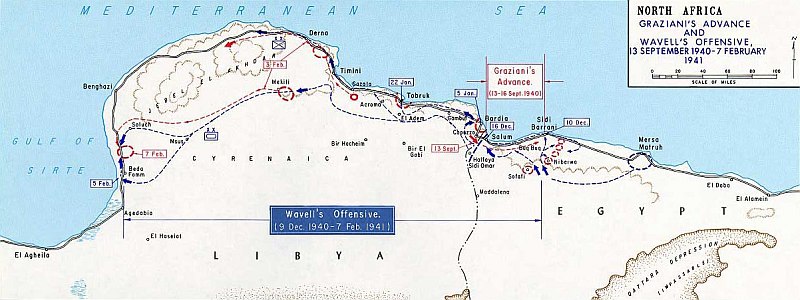
The Matilda Tank was one of the most significant tanks used during the early part of WW2. British tank doctrine split the tank force into two distinct groups: "Infantry Tanks" that were heavily armoured and moved slowly in support of the advancing Infantry, and "Cruiser Tanks" that were fast and mobile. The Matilda fell into the former category - heavily armoured, but slow and unmaneoverable. It saw some success during the battle of France, where its armour proved more than a match for the German anti-tank weapons, but there were too few Matildas available to the BEF and too little support.
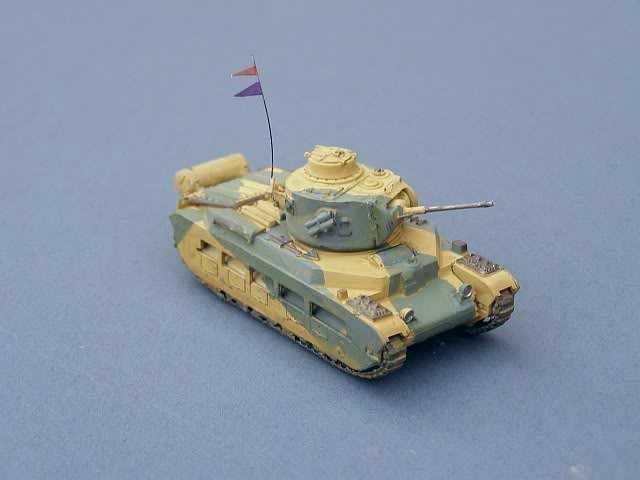
North Africa was a different matter; against the Italian Army and Rommel's Afrika Korps, the Matilda saw greater success, although its twin bus engine propulsion, complex suspension and unreliable steering were ill-matched to the developing form of fast tank maneouvre warfare at which Rommel was the acknowledged expert. Its main armament was also hampered by an inexplicable lack of suitable HE shells. Nevertheless, the heavily armoured Matilda was popular and highly regarded, and played a key role in the successes of the early North African campaign.
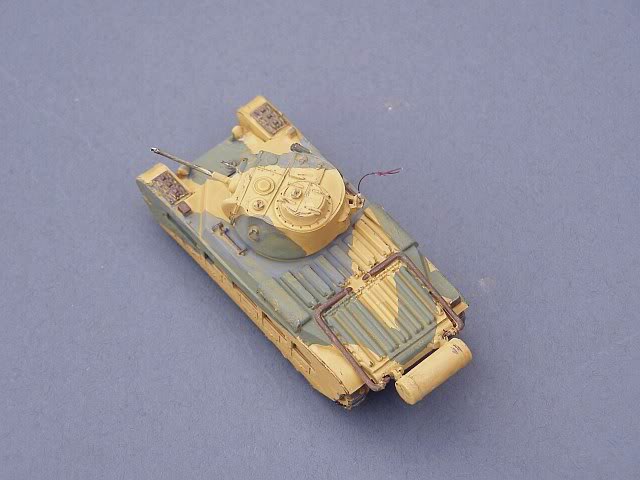
The Airfix Matilda tank is a marvellous little model, even more so in its current incarnation as an Australian version with an anti-bunker mortar attachment on the rear deck. This is in one of the current issues (half the price of the Italeri kit), back-dated to a North Africa tank from Operation Compass in 1940. As with most of the models I have built this year, there is some controversy over colours; if you are familiar with the original Airfix box-art, you may expect the Caunter Scheme camouflage to include light blue - However, recent research suggest that this should have been nearer a slate grey, so this is what I have gone for.
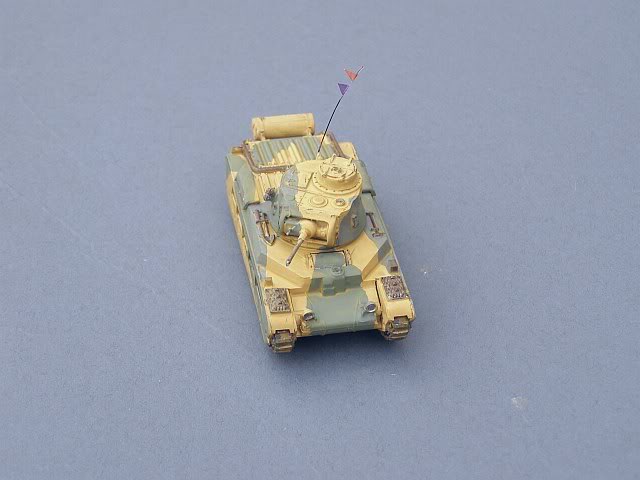
Link to my "Dark Side" AFV Pages
It'll all be over by Christmas - Part 2
Hawker Siddeley Harrier GR.1, 1 Sqn, RAF Wittering, 1970/71.
ESCI AV-8A, 1/72, with Sky decals
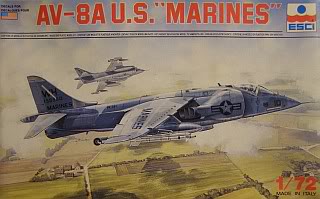
This month sees the final retirement of the Harrier from RN and RAF service, for largely financial reasons. The Harrier was a stunning achievement, revolutionary in concept, yet so 'right' in basic design, that 40 years after it first entered service, today's BAE SYSTEMS / Boeing Harrier II and its uprated Bristol/Rolls Royce Pegasus engine are almost entirely a new designs, yet remain instantly recognisable as a development of the original masterpiece created by the visionary design teams of Hawker's Sir Sydney Camm and Ralph Hooper, plus Bristol's Stanley Hooker.

British Harriers have served with distinction around the world, in the woodland hides of West Germany, the jungles of Belize, from the heaving decks of Royal Navy ships in the South Atlantic and Falklands, above the hostile skies of the Former Yugoslavia and most recently over the mountains and dusty deserts of Iraq and Afghanistan. They remain in service with the Indian Navy, US Marines, Italian Navy, Spanish Navy and Thai Navy.
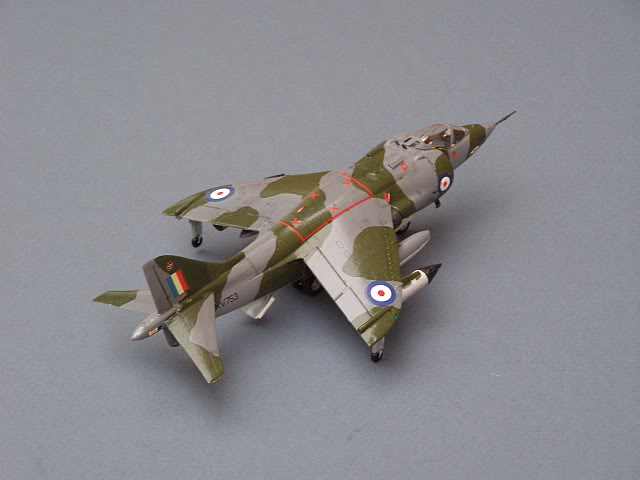

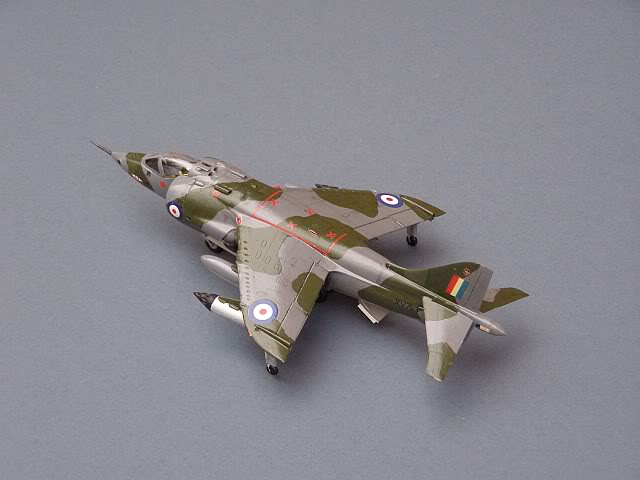
.... And finally: I always try to photograph my models in natural daylight, but at this time of year, this can be a problem.
Anyway, here is a shot of the GR.1 whilst taking the photos above, perched precariously on top of a snow laden roof box in my back garden!
Merry Christmas!
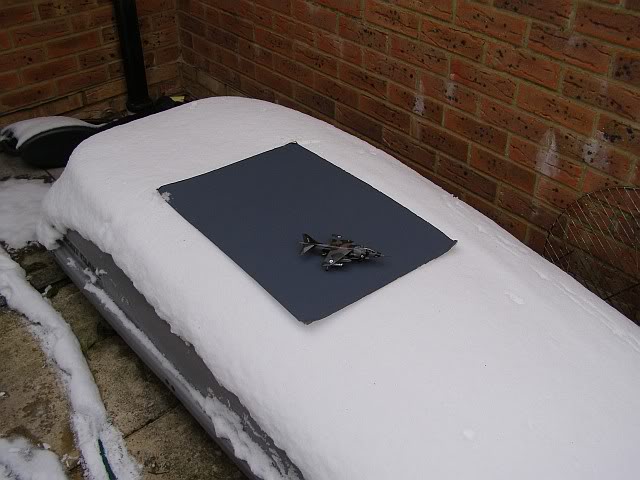
Link to my comprehensive Harrier Pages
www.gengriz.co.uk